 Web Front-end
Web Front-end
 JS Tutorial
JS Tutorial
 4 Ways to Create Objects in JavaScript Detailed Graphical Code Explanation
4 Ways to Create Objects in JavaScript Detailed Graphical Code Explanation
4 Ways to Create Objects in JavaScript Detailed Graphical Code Explanation
4 Methods of Creating Objects in JavaScript Detailed Explanation of Graphic and Text Codes:
1. Factory Mode
Disadvantages: It does not solve the problem of object identification, that is, how to know an object type.

2. Constructor pattern

Compared with factory pattern:
1.No Explicitly create an object
2. Directly assign properties and methods to this object
3. No return statement
To create an instance of person, you must use the new operator, in this way Calling the constructor actually goes through 4 steps:
1. Create a new object
2. Assign the scope of the constructor to the new object
3. Execute the code in the constructor
4. Return a new object
Creating a custom constructor can identify its instance as a specific type.
Disadvantages of the constructor:
Each method is recreated on each instance. Both person1 and person2 have a sayName() method, but the two methods are not the same Function instance. Functions with the same name on different instances are not equal.
There is no need to create two Function instances that complete the same task, and there is also this object. There is no need to bind the function to a specific object before executing the code, as shown below.
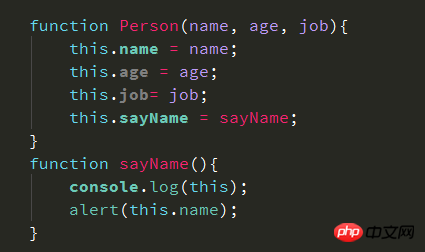
Set the sayName attribute to the global sayName function. In this way, since sayName contains a pointer to a function, the person1 and person2 objects share the same function.
However, if the object needs to define many methods, then many global functions must be defined, and there is no encapsulation of custom reference types. In order to solve the above problems, the prototype mode is introduced.
3. Prototype pattern
Understanding prototype objects
Every function we create has a prototype attribute, which is a pointer pointing to An object whose purpose is to contain properties and methods that can be shared by all instances of a specific type. Prototype is the object prototype of the object instance created by calling the constructor. The advantage of using the prototype object is that all object instances can share the properties and methods it contains.
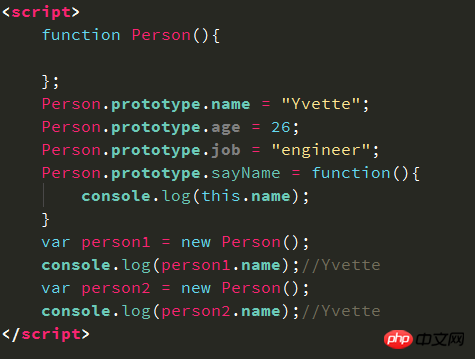
First, the parser will ask the instance person1 whether it has a name attribute, and if so, it will return it.
If not, continue to search for the name attribute in the prototype of person1, and return if there is one.
If not, continue searching in the prototype of person1's prototype.
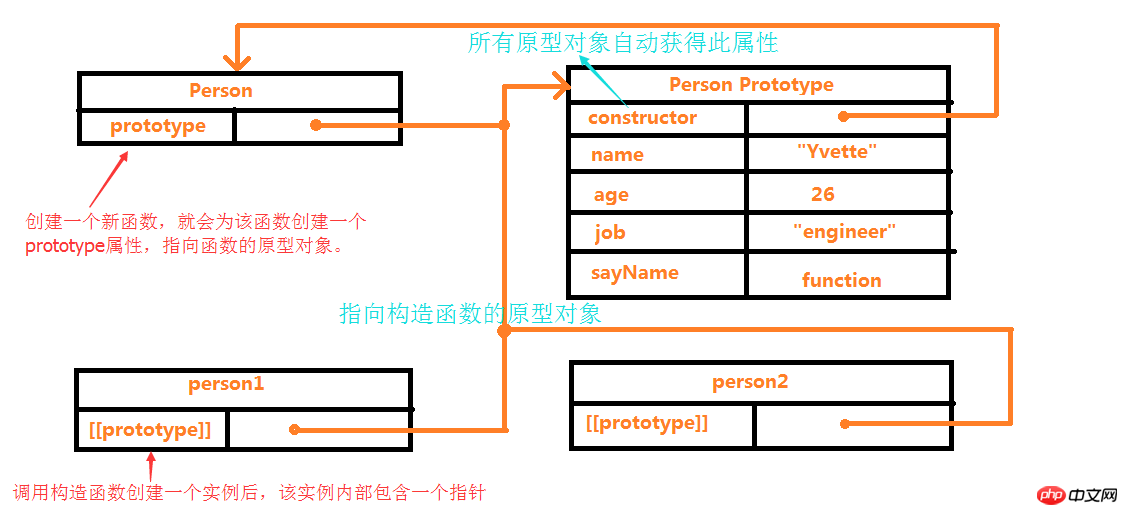
isPrototypeOf() determines the association between the instance and the prototype object
console.log(Person.prototype.isPrototypeOf(person1)); //true
Object.getPrototypeOf( ) returns the value of [[prototype]]
console.log(Object.getPrototypeOf(person1));
//Person {name: “Yvette”, age: 26, job: “engineer”} 返回的是Person的原型对象。
console.log(Object.getPrototypeOf(person1) === Person.prototype)//true
console.log(Object.getPrototypeOf(person1).name);//”Yvette”hasOwnProperty() method can detect whether a property exists in the instance or in the prototype. Only the given property exists in In the instance, true will be returned.
console.log(person1.hasOwnProperty(“name”));//false
Prototype and in operator
There are two ways to use the in operator: alone and in a for-in loop. When used alone, the in operator returns true if the given property is accessible through the object, whether the property resides in the instance or the prototype.
Use the for in loop to return all enumerable properties that can be accessed through the object, including properties in the instance and properties that exist in the prototype. This will also be returned if a property in the instance masks a non-enumerable property in the prototype. There is a bug in the implementation of versions before IE9. Instance attributes that mask non-enumerable attributes will not be returned in for-in.
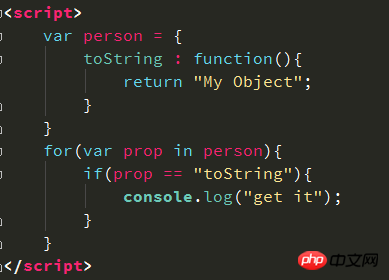
There is no log information in the notebook before IE9. Although the toString() method in the person instance blocks the non-enumerable toString() in the prototype;
Prototype abbreviation
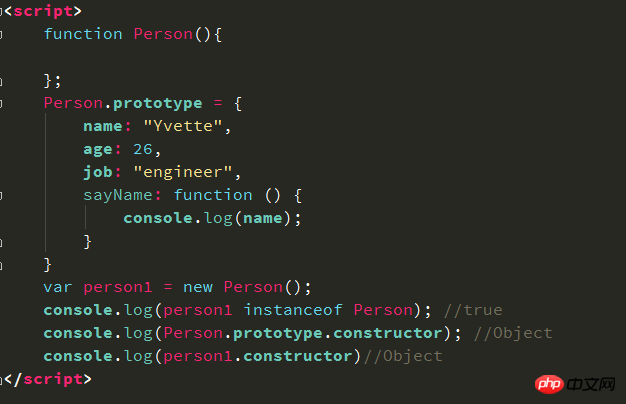
This causes person1.constructor to no longer point to Person, but to Object. If the constructor is important, you need to specifically set it to an appropriate value, such as:
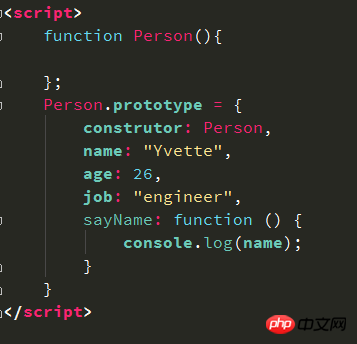
But this approach will cause the constructor property to become enumerable.
If you want to set it to be non-enumerable (the default is not enumerable), you can use
Object.defineProperty(Person.prototype, “constructor”, {
enumerable: false,
value: Person
});The dynamics of the prototype
Since the process of finding a value in the prototype is a search, any modifications we make to the prototype object can be immediately reflected on the instance.
If you rewrite the entire prototype object, the situation is different. When the constructor is called, a [[prototype]] pointer to the original prototype is added to the instance, and modifying the prototype to another object is equivalent to cutting off the connection between the constructor and the original prototype. The pointer in the instance only points to the prototype, not the constructor.
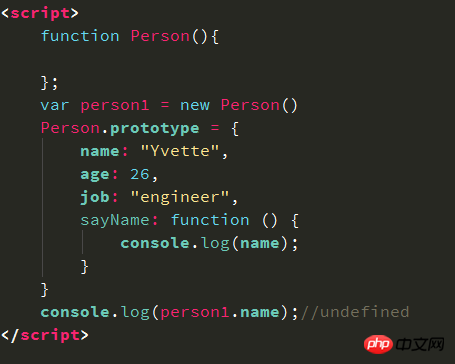
person.prototype points to the original prototype object and does not point to the new prototype object.
Problems with Prototype Objects
The biggest problem with the prototype pattern is caused by its shared nature.
For attributes containing reference type values, the problem is more prominent
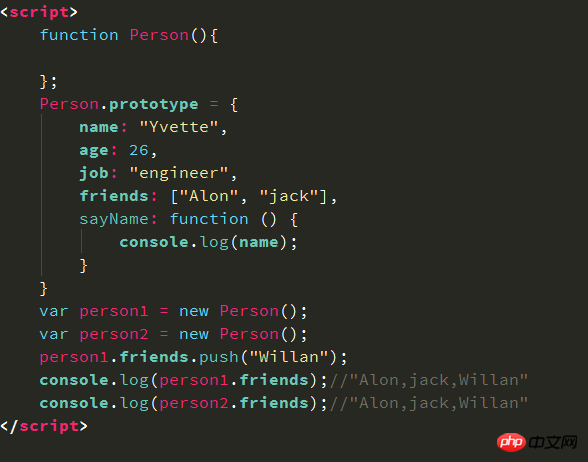
The original intention was to modify person1’s friends, but it resulted in the value of person2’s friends attribute Also changed. Therefore we rarely use prototype mode alone.
4. Use the constructor pattern and the prototype pattern in combination
The most common way to create a custom type is to use the constructor pattern and the prototype pattern in combination. The constructor pattern is used to define instance properties, and the prototype pattern is used to define methods and shared properties. In this way, each instance has its own copy of the instance properties and shares references to methods, which saves memory to the maximum extent. .
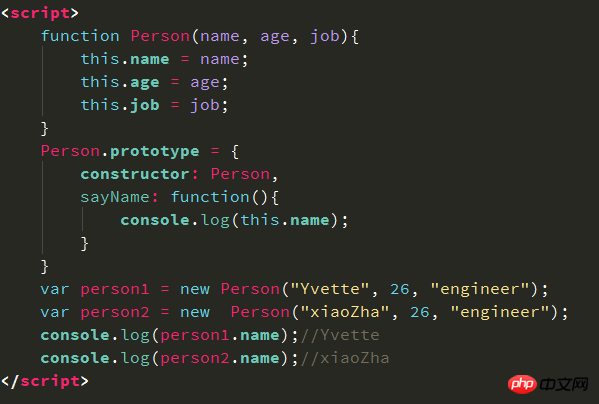
In addition to the above methods, there are also dynamic prototype mode, parasitic construction mode and safe construction mode, but due to the low frequency of use, they will not be described in detail.
The above is the detailed content of 4 Ways to Create Objects in JavaScript Detailed Graphical Code Explanation. For more information, please follow other related articles on the PHP Chinese website!

Hot AI Tools

Undresser.AI Undress
AI-powered app for creating realistic nude photos

AI Clothes Remover
Online AI tool for removing clothes from photos.

Undress AI Tool
Undress images for free

Clothoff.io
AI clothes remover

Video Face Swap
Swap faces in any video effortlessly with our completely free AI face swap tool!

Hot Article

Hot Tools

Notepad++7.3.1
Easy-to-use and free code editor

SublimeText3 Chinese version
Chinese version, very easy to use

Zend Studio 13.0.1
Powerful PHP integrated development environment

Dreamweaver CS6
Visual web development tools

SublimeText3 Mac version
God-level code editing software (SublimeText3)

Hot Topics
 1386
1386
 52
52
 How to solve the problem that activex components cannot create objects
Jan 24, 2024 pm 02:48 PM
How to solve the problem that activex components cannot create objects
Jan 24, 2024 pm 02:48 PM
Solution: 1. Check spelling and path; 2. Add reference to component; 3. Check registry; 4. Run as administrator; 5. Update or repair Office; 6. Check security software; 7. Use other versions Components; 8. View error messages; 9. Find other solutions. Detailed introduction: 1. Check spelling and path: Make sure there are no spelling errors in the name and path of the object, and the file does exist in the specified path; 2. Add references to components, etc.
 How to implement an online speech recognition system using WebSocket and JavaScript
Dec 17, 2023 pm 02:54 PM
How to implement an online speech recognition system using WebSocket and JavaScript
Dec 17, 2023 pm 02:54 PM
How to use WebSocket and JavaScript to implement an online speech recognition system Introduction: With the continuous development of technology, speech recognition technology has become an important part of the field of artificial intelligence. The online speech recognition system based on WebSocket and JavaScript has the characteristics of low latency, real-time and cross-platform, and has become a widely used solution. This article will introduce how to use WebSocket and JavaScript to implement an online speech recognition system.
 WebSocket and JavaScript: key technologies for implementing real-time monitoring systems
Dec 17, 2023 pm 05:30 PM
WebSocket and JavaScript: key technologies for implementing real-time monitoring systems
Dec 17, 2023 pm 05:30 PM
WebSocket and JavaScript: Key technologies for realizing real-time monitoring systems Introduction: With the rapid development of Internet technology, real-time monitoring systems have been widely used in various fields. One of the key technologies to achieve real-time monitoring is the combination of WebSocket and JavaScript. This article will introduce the application of WebSocket and JavaScript in real-time monitoring systems, give code examples, and explain their implementation principles in detail. 1. WebSocket technology
 How to use JavaScript and WebSocket to implement a real-time online ordering system
Dec 17, 2023 pm 12:09 PM
How to use JavaScript and WebSocket to implement a real-time online ordering system
Dec 17, 2023 pm 12:09 PM
Introduction to how to use JavaScript and WebSocket to implement a real-time online ordering system: With the popularity of the Internet and the advancement of technology, more and more restaurants have begun to provide online ordering services. In order to implement a real-time online ordering system, we can use JavaScript and WebSocket technology. WebSocket is a full-duplex communication protocol based on the TCP protocol, which can realize real-time two-way communication between the client and the server. In the real-time online ordering system, when the user selects dishes and places an order
 How to implement an online reservation system using WebSocket and JavaScript
Dec 17, 2023 am 09:39 AM
How to implement an online reservation system using WebSocket and JavaScript
Dec 17, 2023 am 09:39 AM
How to use WebSocket and JavaScript to implement an online reservation system. In today's digital era, more and more businesses and services need to provide online reservation functions. It is crucial to implement an efficient and real-time online reservation system. This article will introduce how to use WebSocket and JavaScript to implement an online reservation system, and provide specific code examples. 1. What is WebSocket? WebSocket is a full-duplex method on a single TCP connection.
 JavaScript and WebSocket: Building an efficient real-time weather forecasting system
Dec 17, 2023 pm 05:13 PM
JavaScript and WebSocket: Building an efficient real-time weather forecasting system
Dec 17, 2023 pm 05:13 PM
JavaScript and WebSocket: Building an efficient real-time weather forecast system Introduction: Today, the accuracy of weather forecasts is of great significance to daily life and decision-making. As technology develops, we can provide more accurate and reliable weather forecasts by obtaining weather data in real time. In this article, we will learn how to use JavaScript and WebSocket technology to build an efficient real-time weather forecast system. This article will demonstrate the implementation process through specific code examples. We
 Simple JavaScript Tutorial: How to Get HTTP Status Code
Jan 05, 2024 pm 06:08 PM
Simple JavaScript Tutorial: How to Get HTTP Status Code
Jan 05, 2024 pm 06:08 PM
JavaScript tutorial: How to get HTTP status code, specific code examples are required. Preface: In web development, data interaction with the server is often involved. When communicating with the server, we often need to obtain the returned HTTP status code to determine whether the operation is successful, and perform corresponding processing based on different status codes. This article will teach you how to use JavaScript to obtain HTTP status codes and provide some practical code examples. Using XMLHttpRequest
 How to use insertBefore in javascript
Nov 24, 2023 am 11:56 AM
How to use insertBefore in javascript
Nov 24, 2023 am 11:56 AM
Usage: In JavaScript, the insertBefore() method is used to insert a new node in the DOM tree. This method requires two parameters: the new node to be inserted and the reference node (that is, the node where the new node will be inserted).



